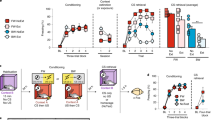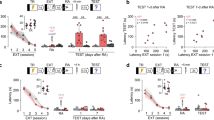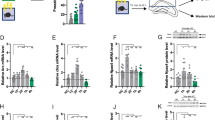Abstract
Fear-inducing memories can be state dependent, meaning that they can best be retrieved if the brain states at encoding and retrieval are similar. Restricted access to such memories can present a risk for psychiatric disorders and hamper their treatment. To better understand the mechanisms underlying state-dependent fear, we used a mouse model of contextual fear conditioning. We found that heightened activity of hippocampal extrasynaptic GABAA receptors, believed to impair fear and memory, actually enabled their state-dependent encoding and retrieval. This effect required protein kinase C-βII and was influenced by miR-33, a microRNA that regulates several GABA-related proteins. In the extended hippocampal circuit, extrasynaptic GABAA receptors promoted subcortical, but impaired cortical, activation during memory encoding of context fear. Moreover, suppression of retrosplenial cortical activity, which normally impairs retrieval, had an enhancing effect on the retrieval of state-dependent fear. These mechanisms can serve as treatment targets for managing access to state-dependent memories of stressful experiences.
This is a preview of subscription content, access via your institution
Access options
Subscribe to this journal
Receive 12 print issues and online access
$209.00 per year
only $17.42 per issue
Buy this article
- Purchase on Springer Link
- Instant access to full article PDF
Prices may be subject to local taxes which are calculated during checkout







Similar content being viewed by others
References
Pompilio, L., Kacelnik, A. & Behmer, S.T. State-dependent learned valuation drives choice in an invertebrate. Science 311, 1613–1615 (2006).
Reus, V.I., Weingartner, H. & Post, R.M. Clinical implications of state-dependent learning. Am. J. Psychiatry 136, 927–931 (1979).
Silberman, E.K., Putnam, F.W., Weingartner, H., Braun, B.G. & Post, R.M. Dissociative states in multiple personality disorder: a quantitative study. Psychiatry Res. 15, 253–260 (1985).
Spiegel, D., Hunt, T. & Dondershine, H.E. Dissociation and hypnotizability in posttraumatic stress disorder. Am. J. Psychiatry 145, 301–305 (1988).
Overton, D.A. Historical context of state-dependent learning and discriminative drug effects. Behav. Pharmacol. 2, 253–264 (1991).
Piri, M., Rostampour, M., Nasehi, M. & Zarrindast, M.R. Blockade of the dorsal hippocampal dopamine D1 receptors inhibits the scopolamine-induced state-dependent learning in rats. Neuroscience 252, 460–467 (2013).
Möhler, H. Molecular regulation of cognitive functions and developmental plasticity: impact of GABAA receptors. J. Neurochem. 102, 1–12 (2007).
Stein, L. & Berger, B.D. Paradoxical fear-increasing effects of tranquilizers: evidence of repression of memory in the rat. Science 166, 253–256 (1969).
Jacob, T.C., Moss, S.J. & Jurd, R. GABA(A) receptor trafficking and its role in the dynamic modulation of neuronal inhibition. Nat. Rev. Neurosci. 9, 331–343 (2008).
Mortensen, M., Patel, B. & Smart, T.G. GABA potency at GABA(A) receptors found in synaptic and extrasynaptic zones. Front. Cell. Neurosci. 6, 1 (2011).
Chandra, D. et al. GABAA receptor alpha 4 subunits mediate extrasynaptic inhibition in thalamus and dentate gyrus and the action of gaboxadol. Proc. Natl. Acad. Sci. USA 103, 15230–15235 (2006).
Blanchard, R.J. & Blanchard, D.C. Crouching as an index of fear. J. Comp. Physiol. Psychol. 67, 370–375 (1969).
Kim, J.J. & Fanselow, M.S. Modality-specific retrograde amnesia of fear. Science 256, 675–677 (1992).
Phillips, R.G. & LeDoux, J.E. Differential contribution of amygdala and hippocampus to cued and contextual fear conditioning. Behav. Neurosci. 106, 274–285 (1992).
Song, M. & Messing, R.O. Protein kinase C regulation of GABAA receptors. Cell. Mol. Life Sci. 62, 119–127 (2005).
Sathyan, P., Golden, H.B. & Miranda, R.C. Competing interactions between micro-RNAs determine neural progenitor survival and proliferation after ethanol exposure: evidence from an ex vivo model of the fetal cerebral cortical neuroepithelium. J. Neurosci. 27, 8546–8557 (2007).
Sengupta, J.N. et al. MicroRNA-mediated GABAAalpha-1 receptor subunit down-regulation in adult spinal cord following neonatal cystitis-induced chronic visceral pain in rats. Pain 154, 59–70 (2013).
Zhao, C. et al. Computational prediction of MicroRNAs targeting GABA receptors and experimental verification of miR-181, miR-216 and miR-203 targets in GABA-A receptor. BMC Res. Notes 5, 91 (2012).
Barmack, N.H., Qian, Z. & Yakhnitsa, V. Long-term climbing fiber activity induces transcription of microRNAs in cerebellar Purkinje cells. Philos. Trans. R. Soc. Lond. B Biol. Sci. 369, 20130508 (2014).
Rayner, K.J. et al. MiR-33 contributes to the regulation of cholesterol homeostasis. Science 328, 1570–1573 (2010).
Medrihan, L., Ferrea, E., Greco, B., Baldelli, P. & Benfenati, F. Asynchronous GABA release is a key determinant of tonic inhibition and controls neuronal excitability: a study in the Synapsin II−/− mouse. Cereb. Cortex published online, doi:10.1093/cercor/bhu141 (24 June 2014).
Orsini, C.A., Kim, J.H., Knapska, E. & Maren, S. Hippocampal and prefrontal projections to the basal amygdala mediate contextual regulation of fear after extinction. J. Neurosci. 31, 17269–17277 (2011).
Radulovic, J., Kammermeier, J. & Spiess, J. Relationship between fos production and classical fear conditioning: effects of novelty, latent inhibition, and unconditioned stimulus preexposure. J. Neurosci. 18, 7452–7461 (1998).
Bozon, B., Davis, S. & Laroche, S. A requirement for the immediate early gene zif268 in reconsolidation of recognition memory after retrieval. Neuron 40, 695–701 (2003).
Xu, W. & Sudhof, T.C. A neural circuit for memory specificity and generalization. Science 339, 1290–1295 (2013).
Girden, E. & Culler, E. Conditioned responses in curarized striate muscle in dogs. J. Comp. Psychol. 23, 261–274 (1937).
Corcoran, K.A. et al. NMDA receptors in retrosplenial cortex are necessary for retrieval of recent and remote context fear memory. J. Neurosci. 31, 11655–11659 (2011).
Goodwin, D.W., Powell, B., Bremer, D., Hoine, H. & Stern, J. Alcohol and recall: state-dependent effects in man. Science 163, 1358–1360 (1969).
Bustamante, J.A., Jordan, A., Vila, M., Gonzalez, A. & Insua, A. State dependent learning in humans. Physiol. Behav. 5, 793–796 (1970).
Weafer, J., Gallo, D.A. & de Wit, H. Amphetamine fails to alter cued recollection of emotional images: study of encoding, retrieval and state-dependency. PLoS ONE 9, e90423 (2014).
Koek, W. Drug-induced state-dependent learning: review of an operant procedure in rats. Behav. Pharmacol. 22, 430–440 (2011).
Colpaert, F.C., Koek, W. & Bruins Slot, L.A. Evidence that mnesic states govern normal and disordered memory. Behav. Pharmacol. 12, 575–589 (2001).
Maren, S., Aharonov, G., Stote, D.L. & Fanselow, M.S. N-methyl-D-aspartate receptors in the basolateral amygdala are required for both acquisition and expression of conditional fear in rats. Behav. Neurosci. 110, 1365–1374 (1996).
Anagnostaras, S.G., Maren, S. & Fanselow, M.S. Scopolamine selectively disrupts the acquisition of contextual fear conditioning in rats. Neurobiol. Learn. Mem. 64, 191–194 (1995).
Davis, M. Diazepam and flurazepam: effects on conditioned fear as measured with the potentiated startle paradigm. Psychopharmacology (Berl.) 62, 1–7 (1979).
Gao, C. et al. IQGAP1 regulates NR2A signaling, spine density and cognitive processes. J. Neurosci. 31, 8533–8542 (2011).
Impey, S. et al. Stimulation of cAMP response element (CRE)-mediated transcription during contextual learning. Nat. Neurosci. 1, 595–601 (1998).
Abel, T. et al. Genetic demonstration of a role for PKA in the late phase of LTP and in hippocampus-based long-term memory. Cell 88, 615–626 (1997).
Merchan, F., Boualem, A., Crespi, M. & Frugier, F. Plant polycistronic precursors containing non-homologous microRNAs target transcripts encoding functionally related proteins. Genome Biol. 10, R136 (2009).
Lin, Q. et al. The brain-specific microRNA miR-128b regulates the formation of fear-extinction memory. Nat. Neurosci. 14, 1115–1117 (2011).
Griggs, E.M., Young, E.J., Rumbaugh, G. & Miller, C.A. MicroRNA-182 regulates amygdala-dependent memory formation. J. Neurosci. 33, 1734–1740 (2013).
Brickley, S.G. & Mody, I. Extrasynaptic GABA(A) receptors: their function in the CNS and implications for disease. Neuron 73, 23–34 (2012).
Moreau, M.P., Bruse, S.E., David-Rus, R., Buyske, S. & Brzustowicz, L.M. Altered microRNA expression profiles in postmortem brain samples from individuals with schizophrenia and bipolar disorder. Biol. Psychiatry 69, 188–193 (2011).
Banigan, M.G. et al. Differential expression of exosomal microRNAs in prefrontal cortices of schizophrenia and bipolar disorder patients. PLoS ONE 8, e48814 (2013).
Penzes, P., Buonanno, A., Passafaro, M., Sala, C. & Sweet, R.A. Developmental vulnerability of synapses and circuits associated with neuropsychiatric disorders. J. Neurochem. 126, 165–182 (2013).
Milenkovic, I. et al. The parvalbumin-positive interneurons in the mouse dentate gyrus express GABAA receptor subunits alpha1, beta2, and delta along their extrasynaptic cell membrane. Neuroscience 254, 80–96 (2013).
Kessler, R.C., Chiu, W.T., Demler, O., Merikangas, K.R. & Walters, E.E. Prevalence, severity, and comorbidity of 12-month DSM-IV disorders in the National Comorbidity Survey Replication. Arch. Gen. Psychiatry 62, 617–627 (2005).
Franklin, K. & Paxinos, G. The Mouse Brain in Stereotaxic Coordinates (Elsevier, 2004).
Huh, K.H. et al. Hippocampal Erk mechanisms linking prediction error to fear extinction: roles of shock expectancy and contextual aversive valence. Learn. Mem. 16, 273–278 (2009).
Ørom, U.A. & Lund, A.H. Isolation of microRNA targets using biotinylated synthetic microRNAs. Methods 43, 162–165 (2007).
Lal, A. et al. Capture of microRNA-bound mRNAs identifies the tumor suppressor miR-34a as a regulator of growth factor signaling. PLoS Genet. 7, e1002363 (2011).
Guzmán, Y.F. et al. Fear-enhancing effects of septal oxytocin receptors. Nat. Neurosci. 16, 1185–1187 (2013).
Yamawaki, N., Borges, K., Suter, B.A., Harris, K.D. & Shepherd, G.M. A genuine layer 4 in motor cortex with prototypical synaptic circuit connectivity. Elife 3, e05422 (2014).
Suter, B.A. et al. Ephus: multipurpose data acquisition software for neuroscience experiments. Front. Neural Circuits 4, 100 (2010).
Acknowledgements
We thank W. Xu and T.C. Sudhof (Stanford University) for providing us with the SynaptoTag viral vector, C. Fernandez-Hernando (Yale School of Medicine) for providing pMIRNA1/pCDH plasmids encoding miR-33 and scrambled miRNA, and the Genomic Core (Northwestern University) for generating lentiviral vectors containing miR-33 and scrambled constructs. We also thank B. Frick and F. Kassam for their help with the behavioral experiments. This work was supported by US National Institutes of Health grants NIH/NIMH MH078064 (J.R.), NIH/NINDS NS061963 and NS087479 (G.M.G.S.), and a Ken and Ruth Davee Award for Innovative Investigations in Mood Disorders, (J.R. and V.J.).
Author information
Authors and Affiliations
Contributions
V.J. and J.R. designed the experiments, analyzed the data and wrote the manuscript. V.J. performed the experiments. K.A.C. and K.L. performed some of the behavioral and biochemical experiments. H.J.C. and A.L.G. helped with the biochemical experiments. N.Y. and G.M.G.S. performed the electrophysiological recordings.
Corresponding author
Ethics declarations
Competing interests
The authors declare no competing financial interests.
Integrated supplementary information
Supplementary Figure 1 Gaboxadol does not affect tone-dependent fear conditioning after i.h. injection.
(a) Gaboxadol (0.1-0.5 µg/hippocampus) did not affect locomotor activity to context or tone at training or activity burst to the footshock (n = 8 mice per group; context 1: F3,22 = 0.814, P = 0.499; tone: F3,22 = 0.431, P = 0.733; shock: F3,22 = 1.109, P = 0.366). (b) In contrast to reduced freezing in context 1, freezing to tone and contextual generalization were unchanged in response to gaboxadol (n = 8 mice per group; context 1: F3,22 = 3.742, P < 0.05; context 2: F3,22 = 0.947, P = 0.434; tone: F3,22 = 0.426, P = 0.737). *P < 0.01 vs vehicle.
Supplementary Figure 2 Scopolamine does not induce state-dependent contextual fear conditioning.
(a) Treatment schedule with scopolamine (25 µg/hippocampus). (b) Scopolamine significantly impaired freezing in all groups including the S-S group, indicating lack of state-dependent contextual fear at doses that impair fear conditioning and memory retrieval (F3,28 = 8.810, P < 0.001). (c) Freezing in the V-S group recovered when mice were tested off drug, whereas the S-V and S-S groups maintained the freezing deficits F3,28 = 3.444, P < 0.05. *P < 0.01 vs V-V group (n = 8 mice/group).
Supplementary Figure 3 Full length images of immunoblots showing increased phosphorylation of PKC βII.
(a) Phosphorylation of PKC isoforms 1 and 24 hrs after fear conditioning. (b) Phosphorylation of PKC βII immeadiately after testing of V-G nd G-G mice.
Supplementary Figure 4 Differential expression of microRNAs that target GABA-related proteins during fear conditioning.
(a) Microarrays of microRNAs differentially expressed in hippocampi of mice after fear conditioning (F) that show > 50% change when compared to control hippocampi from naïve (N) mice. Of nineteen identified microRNAs, fourteen have predicted targets within GABAA receptors, and five of them (marked red) have four or more predicted GABAR targets. (b) Conserved miR-33 targets in GABA-related proteins.
Supplementary Figure 5 Validation of the miR-33 manipulation.
(a) The plasmid construct carrying miR-33 indicates lack of viral toxicity as revealed by viable and healthy neuroblastoma cells infected with LV-SCR or LV-miR-33. (b) qPCR analysis of relative miR-33 level in cells infected with LV-miR-33 vs LV-SCR (t6 = -3.508, P < 0.05, t-test). (c) In vivo validation of the miR-33 overexpression in the mouse hippocampus obtained from mice tested as described in Fig. 3b (n = 5 hippocampi/group; t9=10.297, P < 0.01). (d) Dose-dependent inhibition of miR-33 after i.h. injection of miR-33 LNA when compared to miR-S-LNA (F4,14 = 48.368, P < 0.001, one-way ANOVA). miR-124 levels were determined as a specificity control. (e) and (f) In vivo validation of the miR-33 down-regulation in the mouse hippocampus obtained from mice tested as described in Fig. 3c,d (n = 4 hippocampi/group; t7=8.715, P < 0.01 and n = 4 hippocampi/group; t7=9.12, P < 0.001). *P < 0.05, **P < 0.01, *** P < 0.001 vs corresponding controls.
Supplementary Figure 6 Virus spread and schematic representation of the treatment schedule for the miR-33 experiments.
(a) Spread of lentiviruses along the dorso-ventral hippocampus as revealed by immunohistochemistry with anti-GFP antibodies. (b) Treatment schedule for miR-33 overexpression with LV-miR-33. (c) Treatment schedule for miR-33 inhibition with miR-33-LNA.
Supplementary Figure 7 miR-33 manipulations affects the level of GABA-related proteins but not the level of NMDAR and protein kinases typically required for fear conditioning.
(a) Immunoblots showing the effect of miR-33 overexpression and (b) miR-33 inhibition on the levels of GABRA4, GABRB2, KCC2 and Syn2a,b (quantification shown in Figs. 4b,c,e). (c) miR-33 overexpression did not affect the level of the main NMDAR subunits NR1, NR2A, or NR2B (5 samples/protein/treatment; F2,24 = 2.116, P = 0.115) or (d) protein kinases cAMP-dependent protein kinase (PKA), calcium and calmodulin-regulated kinase II (CaMKII), or extracellular signal-regulated kinases 1/2 (Erk-1/2) (5 samples/protein/treatment; F2,24 = 0.31, P = 0.861).
Supplementary Figure 8 Proteomic analyses of hippocampal protein samples after miR-S-LNA or miR-33-LNA treatment.
(a) 2D Gel Difference Image of averaged Sample A (vehicle-injected group) vs averaged Sample B (gaboxadol-injected group). Polypeptide spots increased in Sample A vs Sample B are outlined in Blue, while spots decreased in Sample A vs Sample B are outlined in Red. (b) The spot later identified as synapsin-2. (c) Identification of differentially produced proteins by mass spectrophotometry.
Supplementary Figure 9 Coordinates for infusions and immediate early gene response quantification.
(a) Hippocampal coordinates used for infusion of drugs, viruses, and microRNAs (left), and an example of cannula placement (right). (b) Higher magnification showing cannula traces in the CA1 subfield of mice injected with SynaptoTag followed by gaboxadol in images showing synapsin (green) and mCherry (red) (left) or EGR-1 (blue, right). (c) Coordinates used for quantification of EGR-1 and cFos immunostaining.
Supplementary Figure 10 cFos responses after fear conditioning with gaboxadol.
Individual photomicrographs of average cFos (pseudocolored green) immunostaining in different groups and brain areas. Significant changes were found in the lateral septum (F2,8 = 5.232, P < 0.05) *P < 0.05, **P < 0.01, when compared to the V group.
Supplementary information
Supplementary Text and Figures
Supplementary Figures 1–10 (PDF 1571 kb)
Supplementary Methods Checklist
(PDF 455 kb)
Rights and permissions
About this article
Cite this article
Jovasevic, V., Corcoran, K., Leaderbrand, K. et al. GABAergic mechanisms regulated by miR-33 encode state-dependent fear. Nat Neurosci 18, 1265–1271 (2015). https://doi.org/10.1038/nn.4084
Received:
Accepted:
Published:
Issue Date:
DOI: https://doi.org/10.1038/nn.4084
This article is cited by
-
Stress-induced changes of the cholinergic circuitry promote retrieval-based generalization of aversive memories
Molecular Psychiatry (2022)
-
Stress-induced generalization of negative memories is mediated by an extended hippocampal circuit
Neuropsychopharmacology (2022)
-
Sex-specific roles of hippocampal microRNAs in stress vulnerability and resilience
Translational Psychiatry (2022)
-
Presynaptic GABAB receptor inhibition sex dependently enhances fear extinction and attenuates fear renewal
Psychopharmacology (2021)
-
microRNA-33 maintains adaptive thermogenesis via enhanced sympathetic nerve activity
Nature Communications (2021)



